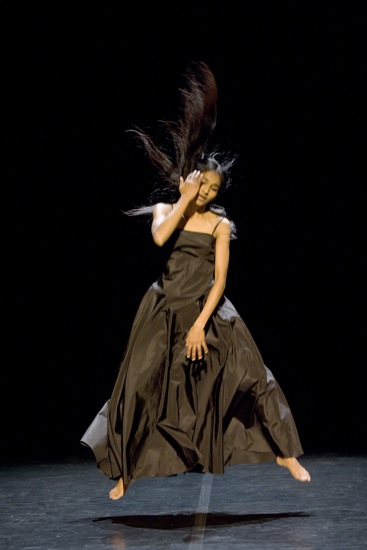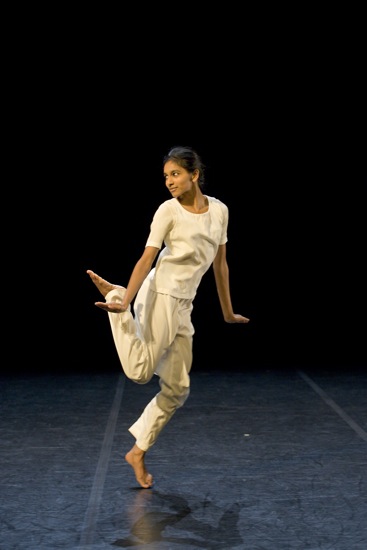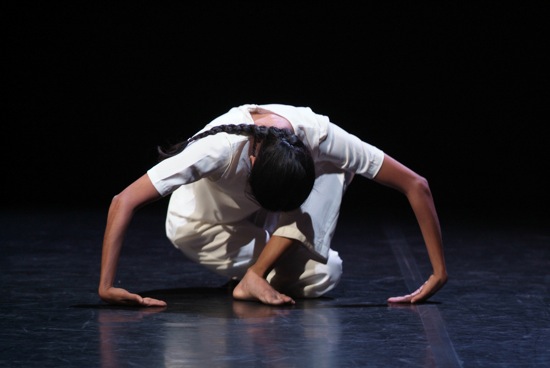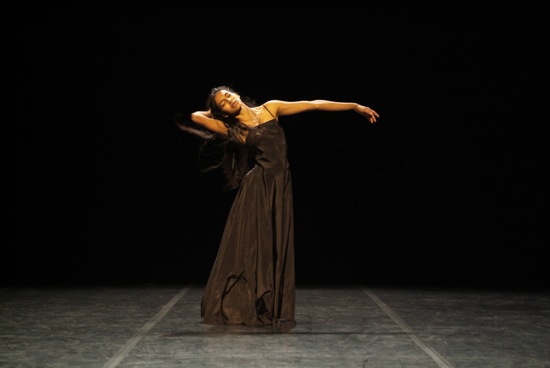Shantala Shivalingappa has always been an artistic voyager. Trained in India’s classical Kuchipudi style (first by her mother, Savitry Nair, then by Vempati Chinna Satyam), she danced with an unbridled white horse in Bartabas’s equine spectacle Chimère. She played Ophelia in Peter Brooks’s production of Shakespeare’s Hamlet and Miranda in his The Tempest. She has performed with Pina Bausch’s Tanztheater Wuppertal. In 2010, she collaborated on a duet with choreographer-performer Sidi Larbi Cherkaoui that I wish they would present here.
She’s exquisite on stage—slender and delicately built, but with reserves of strength. She has the look of a deer—shy, capable of freezing andthen springing away in an instant. Her long, flexible fingers make the gestures of Kuchipudi wonderfully legible, and her arms ripple like snakes. Certain themes from classical Indian poems and epics suit her perfectly. Picture her as Radha, desolate because she has decked herself with flowers and Lord Krishna has still not arrived.
Curiously Namasya, the program she conceived and performed at the Joyce Theater (June 27 to July 1) in homage to influential friends and mentors, doesn’t show the range she’s capable of. The four works she presented are by different choreographers. Ushio Amagatsu, founder of Japan’s Sankai Juku, contributed Ibuku (or “vital breath”). Savitry Nair choreographed Smarana for her daughter. Shivalingappa herself made Shift and co-developed Solo with Pina Bausch. Yet each creator seems to view Shivalingappa in the same—or very similar—way. Each dance reveals her as meditative and gentle, alert to her surroundings but perhaps seeking something beyond their borders. She brings the same presence to each. Certain movements even cross the boundaries between dances—a particularly lovely flower-like gesture of both hands, a bent-kneed kick behind her as she travels along.
Contrast, clearly, isn’t something she considered; instead, in each dance she plays elegantly and skillfully within a small compass of moods and dynamics—making much out of a little. It’s a bit like hearing a song that confines itself to two octaves. Between the first and second dances and the second and third, portions of a video by Alexandre Castres cover Shivalingappa’s costume changes. They do provide a contrast to the serenity of the program, although not in a desirable way. Images of Shivalingappa performing a piece from her Kuchipudi repertory are zoomed in on, cut away from, and inverted with an artiness that’s almost gaudy. She appears to be dancing in a shallow pool, and sometimes her reflected face is deconstructed by ripples.
For Amagatsu’s Ibuku, Shivalingappa wears white pants and a vest. The dance begins with her lying curled up on the floor within a rectangle of dim light provided by Nicolas Boudier. The music, by Yoichiro Yoshikawa, is quietly, sparely atmospheric. Through the dance, you feel an upward tendency that draws Shivalingappa to her feet and across the space, and induces sudden spurts of energy and little jumps. Her hands define small, nimble tasks. Is that a bird she reaches for, and does it fly? The pace is very slow, but the solo has none of the physical distortions associated with butoh. The dancer is the innocent seeker who rises, experiences something, and returns to her spot on the floor.
When Shivalingappa walks onstage wearing a long silk gown held up by slender straps and with her hair released from its braid, you don’t need to look at the printed program to know that this is the piece co-created with Bausch. Of all the works on the program, this one has the most variegated dynamics and designs. Shivalingappa explores more extremes of space—places her feet wide apart, rising and sinking to recorded music by the Spanish singer and guitarist Ferran Savall. Suddenly she drops to one knee, sways her torso sinuously, collapses. At the end of the solo, she just walks offstage.
She wears the same black pants and draped tunic for both Shift and Smarana. The first (also to music of Savall’s) begins in a narrow ribbon of space across the front of the stage, which she traverses low to the ground. At one point, scrabbling like a little animal, she jumps in a crouch. That’s a small surprise. For almost the entire duration of Smarana, she sits on her heels, her back to the audience. In that position, she ripples her torso dreamily from side to side, sways her hips, snakes her arms in opposing curves, and forms shapes with her fluent fingers, while classical Indian music sighs along with her.
In the end, you remember those beautiful hands; in all the dances they articulate images that aren’t as literal as those of Kuchipudi, but nevertheless hint at objects and desires. All the solos make use of her sinuous arms and her gift for defining small, telling changes in speed and impetus; the choreographers all hymn her lightness, her clarity, her fluidity. It’s as if you’ve been sitting for around an hour watching one long, tranquil dance with only minimal variations.





For the information of readers,the above pingback leads to a translation of my post on Shantala Shivalingappa into Turkish. It appeared in the journal, Mimesis. As I recall, no one asked my permission to do this, but I would not have denied that.